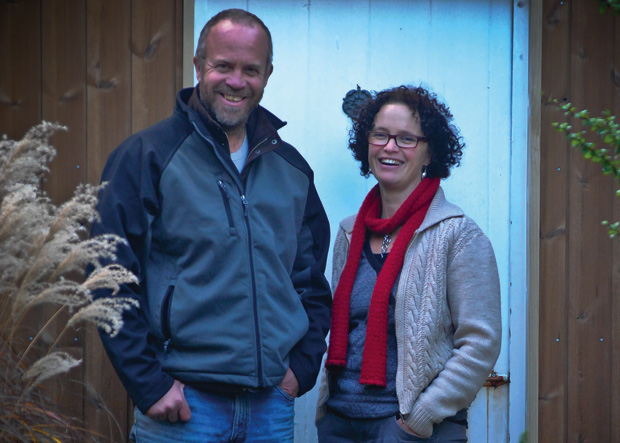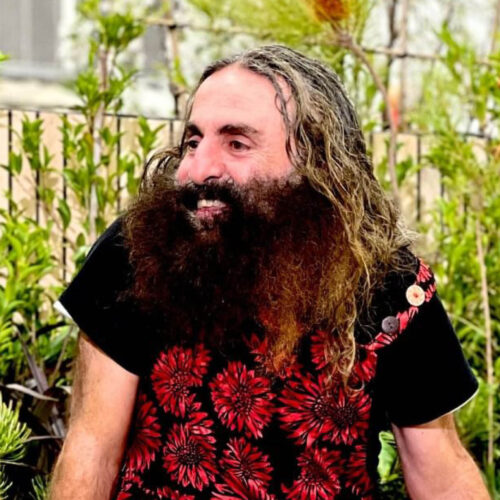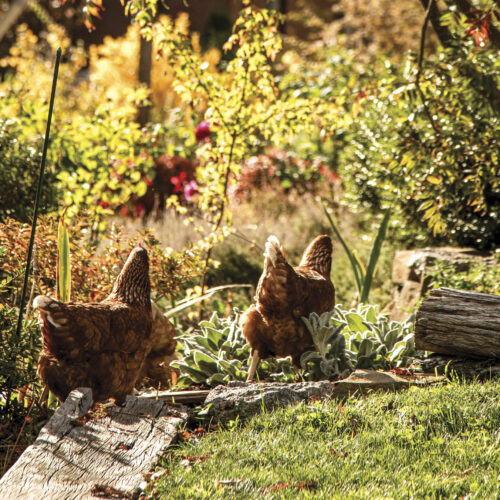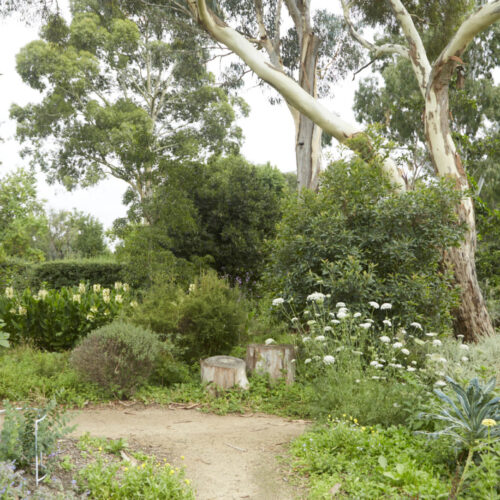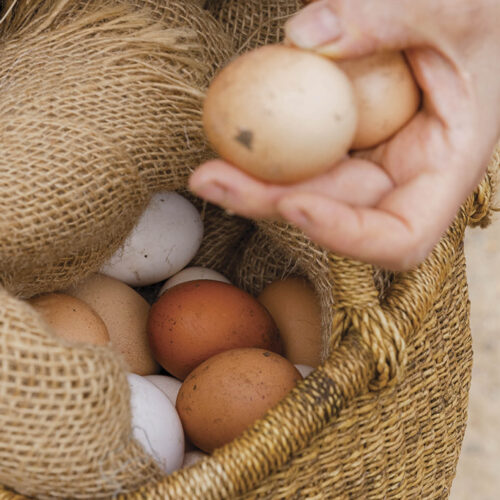Wychwood magic
2012-10-02T02:32:41+10:00
HELEN CUSHING visits Wychwood Garden and Nursery – a living work of art where the palette includes a productive mix of exotic plants, fruit and vegies, as well as a magical twist.
Set in the tiny village of Mole Creek in northern Tasmania’s lush dairy country, Wychwood Garden and Nursery is an irresistible temptation for gardeners both budding and experienced; a work of love, art and productivity. Owners Peter Cooper and Karen Hall have built from scratch a wonderful world where nature’s sweetest creations have merged with inspiration and innovative design to create a vibrant habitat for raising a family.
It all started in 1991, when Peter was studying horticulture in Brisbane and the couple decided to move to Tasmania, sight unseen, for a slice of the good life.
“The whole idea about coming to Tasmania was to find the quality and simplicity of life that so many people have lost,” says Karen. “We discovered Mole Creek, bought a house on half an acre and later added the two acres that go down to the creek.”
Part of the attraction was the fact that the area was embedded with strong values of family, community and a connection with nature.
“It’s a true community,” says Karen. “The farmers still live off the land. Our neighbour has a smokehouse that’s always been there. People raise and kill their own meat. Many times we’ve had a phone call saying, ‘We’ve got a pig, do you want half?’ In return we give them some plants or Peter lends a hand in the garden.”
The couple set down their roots and started a garden maintenance business, which sent their creative juices into overdrive with plans for their own productive plot.
“We had a few jobs in inspirational gardens and realised what we could do on our bare paddock,” says Peter. “We got excited about gardening.”When their children were born (Holly and Louis, now aged 17 and 15), they started the nursery so Karen could work from home. “It was important for me to be at home with the kids,” she says. “The garden has given us their childhood. Family, friends and home are the important things.”
Fruitful endeavours
The edible gardens, as with all elements of Wychwood, are beautiful, diverse and functional. The ordered vegetable area has an arched entrance supporting an espaliered ‘Cat’s Head’ apple. “It’s one of the first known varieties of apple named in literature. I make ‘Cat’s Head’ chutney, which confuses some people!” laughs Karen.
In the garden, small fruits grow alongside vegetables and herbs. Raspberries, boysenberries, loganberries, red and black currants and blueberries are mulched with pine needles, and thrive in the acidic soil created by nearby conifers.
Frost can strike at any time, and winds off the mountains sweep through with force. The garden is fenced with canes from coppiced hazel and black willow, doubling as a trellis for climbers. Vegie seed is saved or bought from a Tasmanian organic seed seller.
The heritage apple orchard, which is shared by quinces, pears, plums, geese and chooks, is a feature of Wychwood. The geese graze, fertilise and clean up the windfall in the orchard, which is mulched with hedge prunings. Elsewhere in the garden, apples are espaliered on north and west-facing walls.
“We grow 40 varieties of heritage apples and firmly believe in the importance of saving this gene pool,” says Karen. “Peter makes cider with the leftover apples. Every year it tastes different. Our best vintage was 2006. Friends with spare apples often join in the pulping and pressing.”
A work of art
The garden not only feeds the family but also provides a backdrop for special events showcasing local produce. Every two years a heritage apple tasting day draws up to 600 people and in 2011 a new event, Locally Delicious @ Wychwood, invited the best food producers from the area to set up stalls in the abundant garden. Over 700 visitors made themselves comfortable with picnic rugs in the autumn sunshine while they sampled wines, beers, cheeses, small goods, honey, gelati, fresh apple juice and much more.
In 2010 Art in the Garden turned Wychwood into an inspiring showcase for sculpture in stone, metal and timber as well as basketware, textiles and pottery, all by leading Tasmanian artists. Fittingly, art is ever present at Wychwood, not only in the sculptures that appear to grow out of the soil but also in the garden itself, which is a living work of art.
Through its design and planting, the garden has qualities that are both sculptural and artistic. It is a composite of exquisite miniatures that blend without distinction into the vision of the whole.
“Our garden has a sense of peace and flow,” says Peter.
A feature of the garden that reflects Peter’s Scandinavian background is the labyrinth (before moving to Queensland, he spent his first eight years in Sweden and his mother was Finnish). Childhood memories of holidays in Finland left a strong impression of the landscape.
“We thought we’d put in a maze,” says Peter. “In our research we came across labyrinths. They’re a universal symbol in traditional cultures and are particularly numerous in Sweden – some are thousands of years old.”
The Wychwood labyrinth is laid out in raised turf and easily found its way into Peter’s overall design aesthetic. “It’s like a path of life,” he says. “When you walk it, you end up back where you started. The circles and spirals became part of my design concept. We just can’t seem to do straight lines.”
While the labyrinth creates spirals in relief across the earth, it also rises out of the ground in the form of tapering spiralled hedges. The trimmed formality of the hedges is softened by the harmony of the spiral, and further contrasted by various centrepieces. From inside one, a languid ‘Huonville Crab’ (as in crab apple) reaches its long-armed branches across the boundaries of the hedging.
In autumn the hanging boughs of this friendly tree are heavy with large, deep red fruits that have a beautiful crimson flesh. Other hedge spirals contain Peter’s rusted sculptures; structures with strong forms and obscure identity.
Exotic design
Along with the food gardens, the striking ornamental areas of Wychwood are planted entirely with exotics. “We grow what we love,” says Peter. “We’re not against natives, we just don’t think they blend well with exotics, and aesthetics drive the design. Contrasting foliage and texture come first; flowers are secondary. We’re not collectors and we’re not interested in fashion.”
Wychwood is filled with plants that perform across the seasons, such as crab apples, cherry blossoms, species roses and clumping grasses. Plants are massed in beds that curve around deep green lawns. Repetition in planting is important in the design.
“Within the beds we’re not overly fussy,” explains Peter. “We like a natural look. For example, we don’t go around dead-heading. This contrasts with the neat edges.”
Not dead-heading also lets nature take its course. An abundance of seed heads and berries lend seasonal structure and colour to the garden, while supporting a wide diversity of birds. Sixty-three species have been counted, showing that exotic gardens can support birdlife.
“Once the cats went, the bird numbers built up, and as the garden matured they started nesting here,” says Karen. “We get all the honeyeaters plus birds of prey, owls and bats. Using species plants is important. There is a good supply of seed, berries and nectar. The birds feel safe here.”
While all imported seeds sown at Wychwood are checked by Australian Quarantine and Inspection Services, Karen and Peter are aware that their preference for exotic species raises questions about ‘environmental credentials’, but they defend their choice: “Does a paddock of organically grown potatoes have good environmental credentials? They are exotic, as are cows, apples and grapes. Pasture grass is exotic,” says Peter.
“Then there is the argument about what is native – a plant that is indigenous to your locale only, or Australia in general? The weed potential for many natives is as bad, if not worse, than for some exotics.”
While Karen believes that the issue should be about the importance of growing, not just about what you grow – about “getting outside, getting your hands dirty, planting a tree that your grandkids can sit under one day”.
“Our lives revolve around gardening and growing things,” she says. “We have established a life and lifestyle out of gardening – saving and sowing seed, digging the earth and creating something of beauty. People have come to our garden and cried. Some have gone home and decided to start gardening for the first time in their lives because of what we have achieved here.”
Intuition and design
In spite of Peter’s expertise as a garden designer, Wychwood was never drawn up on paper, and like so many extensive and beautiful gardens, Peter and Karen just kept moving the fence back as the garden expanded.
The work of English plantswoman Beth Chatto and contemporary Dutch garden designer Piet Oudolf have also inspired and shaped Peter and Karen’s gardening. “Beth Chatto says ‘Grow things where they like to grow’. Oudolf promotes a naturalistic style, growing for structure, keeping seed heads – more of a prairie feel,” says Peter.
In tune with these philosophies, Wychwood is very much situated in its wider environment. “We’re conscious of having beautiful vistas – views of Mother Cummings Peak, a rusty old barn; we like to create pictures and frame them with trees.” This also makes the garden look bigger, as it becomes part of the vastness of the surrounds.
Natural balance
Pest and diseases are not a major concern at Wychwood, defying the idea that exotic plants are high maintenance. “We have very little need for pest control,” says Karen. “Obviously, when an issue arises, such as a bad year for aphids, we are aware of it, but we find that a balance is usually restored on its own.
“Our plants are healthy and happy growing in a climate that suits them. This means they can fend off and survive attack by pests. We advocate growing plants that suit the climate rather than trying to create an artificial environment where plants struggle against their needs. Often a pest or disease problem is climatic – a wet spring, perhaps – and once the weather pattern moves on, the problem goes away.”
With such a large garden to maintain, the approach to fertilising also needs to be efficient – the hard work of composting is done by the chooks who need little supplementary feeding after feasting on the family’s kitchen scraps. Their bedding is used on the garden and the fruit and vegetables are fed with organically certified pelletised chicken manure, seaweed and blood and bone.
Pea straw is used to mulch the vegies and ornamental beds, although the beds are now so dense with plants that there is little room for mulch. Mulching mowers are used on the lawns so that the grass clippings stay where they fall.
Karen’s nursery nestles in among trees, shrubs and rambling vines. “I grow everything hard, not under glass,” she says. “The pots freeze solid in winter so the survival rate for customers is high as the plants are strong. I ignore plant trends. What we sell reflects the garden.”
Karen’s shop, which adjoins the nursery and garden, is also a visual feast, with items including customised Wychwood Ceramics, an array of natural twines and Peter’s striking photographs of the garden.
Despite the garden and nursery being open to the public, Karen says it has been very much a place for their children, now teenagers. A fairytale playhouse, swimming in the creek and browsing the berries and apples have just been part of growing up for them. A barbecue and outside pizza oven further blend family life with the outdoors.
“We’re home-bodies,” says Karen. “The children are very much part of everything we do. We’ve created an idealistic life. It’s a big part of who we are, of our identity.”

